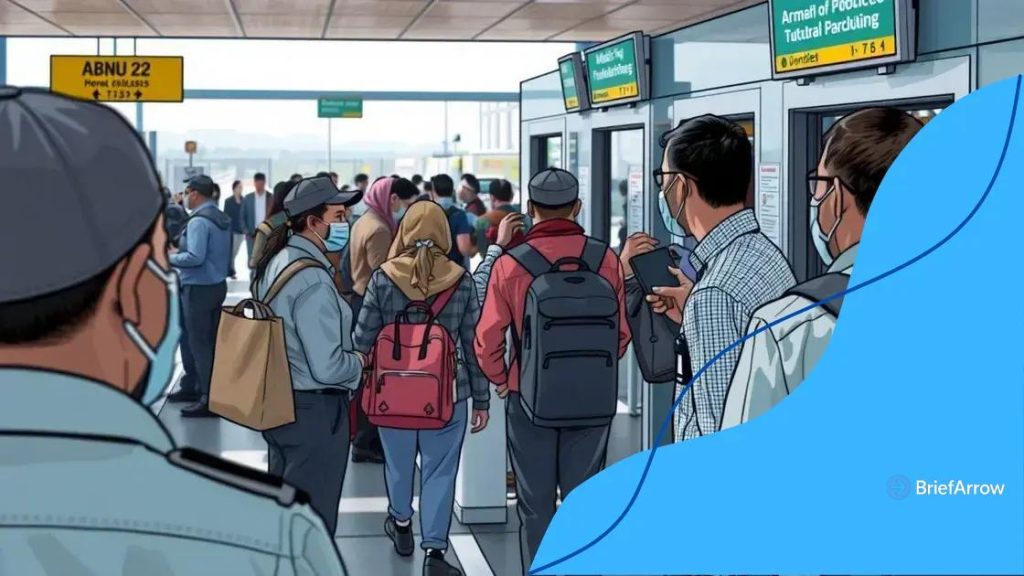Administration outlines new border control strategies

Anúncios
Administration outlines new border control strategies that enhance security through advanced technologies, international collaboration, and community engagement, aiming to balance safety with efficient travel for individuals and goods.
Administration outlines new border control strategies that are set to reshape how we manage our borders. Have you wondered how these new measures could affect travel and security? Let’s dive into the details.
Anúncios
Current border control measures
Understanding the current border control measures is essential in today’s world. These strategies play a crucial role in ensuring safety and managing cross-border activities effectively.
Key Components of Border Control
Several vital components contribute to effective border management. These include:
- Increased surveillance: Technologies such as drones and cameras enhance monitoring capabilities.
- Access control systems: Advanced systems aid in regulating who enters and exits.
- Trained personnel: Skilled officers ensure smooth and secure processing of travelers.
Another important aspect is the implementation of biometric systems at checkpoints, which helps to verify identities promptly.
Anúncios
Integration of Technology
The integration of technology in border control has transformed traditional procedures. Automated systems streamline processing, reducing wait times for travelers. Additionally, information sharing between countries enhances security measures.
Countries are also focusing on data analytics to identify patterns in border crossings. This proactive approach allows for swift responses to potential threats.
Maintaining a balance between security and facilitating travel is key. The current measures aim to protect citizens while ensuring that commerce and tourism can proceed without unnecessary hindrance.
Recent changes in policies
The recent changes in policies regarding border control are significant and impact various aspects of the process. These changes aim to adapt to evolving security needs while ensuring the flow of legitimate travel.
Overview of New Regulations
Policymakers have introduced several new regulations to enhance border security. These include:
- Stricter entry requirements: New guidelines require additional documentation for travelers.
- Increased vetting processes: Enhanced background checks on travelers ensure a higher level of security.
- Suspension of certain programs: Some existing programs meant to expedite processing have been paused to reassess their effectiveness.
Another notable policy shift involves collaborative efforts with nearby countries to unify border protocols. This not only speeds up processing but also fosters better international relations.
Effect on Travelers
Travelers need to be aware of how these changes will affect them. With the new policies in place, wait times at borders may increase initially as the systems are adjusted. It is essential for travelers to plan ahead and allow for extra time during their journeys.
Moreover, the introduction of digital verification measures has provided a quicker means to confirm identities. This balances increased safety while aiming to lessen delays as much as possible.
Impact on national security

The impact on national security due to changes in border control strategies is significant and multifaceted. As policies evolve, they aim to strengthen safety while balancing efficiency in travel.
Enhanced Security Measures
New border strategies often involve implementing more stringent security measures. This includes:
- Increased surveillance: The use of cameras and advanced technology helps monitor activities at borders.
- Coordination with intelligence agencies: Collaborating with different agencies ensures better information sharing and threat detection.
- Stricter vetting processes: Enhanced background checks lead to a more secure travel environment.
These measures serve not only to protect the borders but also to provide a sense of security to citizens. As officials identify potential threats, these actions can prevent incidents before they occur.
Effects on Threat Assessment
The evolving strategies also impact how threats are assessed. With improved technology, agencies can analyze data more effectively and respond quickly to potential risks. For example, the integration of AI in threat detection systems allows for a more proactive approach.
Moreover, a keen focus on cross-border cooperation can address security challenges that are not confined by geographic boundaries. Joint exercises and shared resources foster a united front against threats.
Public reaction to new strategies
The public reaction to new strategies in border control has brought forth various opinions and feelings. Understanding these reactions is vital as they can influence policy adjustments and the overall effectiveness of these strategies.
Varied Perspectives
Many people express support for the changes, citing enhanced security as a key benefit. They feel that stricter measures provide better protection against potential threats. Others, however, voice concerns about their impact on freedom of movement.
- Support for increased security: Citizens believe that tighter controls help reduce crime and terrorism.
- Concerns about efficiency: Some worry that longer wait times at borders could disrupt travel and trade.
- Privacy issues: Many are uncomfortable with the enhanced surveillance involved in these strategies.
This division in public opinion creates challenges for policymakers, who must work to balance security with the rights of individuals. Keeping the dialogue open between officials and the public is essential for future policy effectiveness.
Community Engagement
Communities are increasingly engaging in discussions regarding border policies. Forums and town hall meetings have become common, offering platforms for citizens to express their views and ask questions. These discussions provide insight into public sentiment and can shape future adjustments in border management.
As people share their experiences, officials gain valuable feedback that can help in fine-tuning the balance between safety and convenience. Educating the public about the reasons behind these strategies can also foster greater understanding and support for necessary measures.
Future developments in border control
The future developments in border control are poised to redefine how nations secure their borders while facilitating travel. Innovations in technology will greatly influence these changes.
Technological Advancements
New technologies are emerging that promise to enhance border security systems. Some of these advancements include:
- Facial recognition: This technology will aid in quickly verifying identities at checkpoints.
- Automated border control kiosks: These self-service stations will streamline the entry process for travelers.
- Data analytics: Utilizing big data to assess patterns in travel can help predict and mitigate potential security threats.
As these technologies become integrated into existing systems, they will not only improve efficiency but also enhance overall security measures.
Policy Innovations
Future border control policies are likely to prioritize collaboration among nations. Countries may develop shared security agreements that allow for more effective responses to threats. Enhanced information sharing will play a crucial role in this collaboration.
In addition, there will likely be a greater emphasis on protecting human rights while implementing these measures. Striking a balance between ensuring safety and upholding freedoms will continue to be a delicate task for policymakers.
Furthermore, adapting to global challenges such as pandemics and climate change will demand flexible approaches. Border control strategies must evolve to address these complex issues while maintaining security.
In conclusion, the evolving landscape of border control strategies reflects a balance between enhancing security and facilitating travel. With advanced technologies and collaborative policies, future developments will likely prioritize both protection and efficiency. Understanding the public’s reaction is crucial as it shapes how these strategies are implemented. Engaging communities, addressing concerns, and promoting transparency will ensure that border control remains effective and fair for all. As we look ahead, keeping these elements in mind can lead to a more secure and open world.
FAQ – Frequently Asked Questions about Border Control Strategies
What are the key benefits of new border control technologies?
New technologies help enhance security, streamline processing time, and improve traveler experiences at border checkpoints.
How do public opinions affect border control policies?
Public feedback shapes policies by highlighting community concerns and preferences, ensuring that measures remain effective and fair.
What is the role of international collaboration in border control?
International collaboration helps strengthen security measures through information sharing and joint strategies to tackle cross-border threats.
How can travelers prepare for new border control measures?
Travelers should stay informed about policy changes, allow for extra time at borders, and ensure they have the appropriate documentation ready.